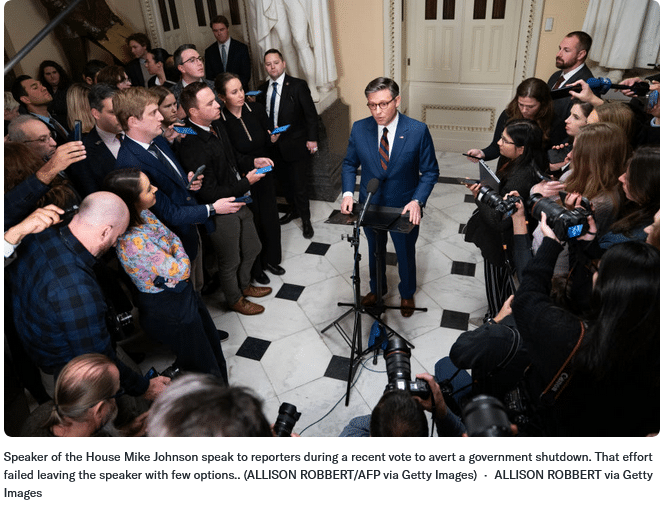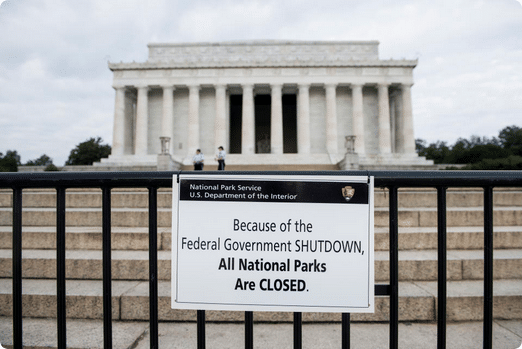The United States government could be headed towards a shutdown this weekend after two failed attempts by House Republicans in recent days to avert a stoppage.
First, Speaker Mike Johnson and his colleagues saw one bipartisan deal fall apart amid opposition from Elon Musk and President-elect Donald Trump. Then a second GOP-negotiated deal collapsed due to 38 House Republicans joining nearly all Democrats to vote no and tank that effort.
Johnson and his colleagues are still working feverishly to resolve a complex series of disputes on issues like the debt ceiling to various funding priorities but now have only hours to act to head off an array of impacts that could be felt across the country as well as economic impacts that could grow with each passing day.
“We will regroup and we will come up with another solution so stay tuned,” was all Johnson was able to offer reporters after Thursday’s latest failed vote.

For now experts are downplaying the immediate economic effects and noting that lawmakers have intense motivation to find a deal and then get home for the holidays.
“Nobody wants the optics of shutting down the government,” Stifel Chief Washington Policy Strategist Brian Gardner noted in a Yahoo Finance Live appearance on Thursday, noting noting a shutdown would include things like temporarily unpaid military personnel.
But with few options left, what could be a growing economic question for the coming days is the length of any stoppage — especially in the middle of the holiday travel season.
TSA Administrator David Pekoske tried to assuage some concerns Thursday when he noted in a post that about 59,000 of his agency’s over 62,000 employees “are considered essential and would continue working without pay in the event of a shutdown.”
But he was quick to add a warning: “please be aware that an extended shutdown could mean longer wait times at airports.”
If a shutdown begins to drag out, the bite could begin to be directly felt on Monday morning at the beginning of the workweek.
Many America’s more than 2 million federal employees (and another 2 million military personnel) could either find themselves furloughed, be working without pay, or simply dealing with shutdown related disruptions.

The effects would be felt by individuals but also many businesses that rely on the government on a day-to-day basis.
At the same time, wide swaths of the government are set to be largely unaffected — notably Social Security and Medicare.
Money for those so-called “mandatory spending” represents a majority of the government’s budget and supports programs like Social Security and Medicare. That is set to continue no matter what happens on Capitol Hill.
Here’s a rundown of just some of what is set to remain accessible and what will be on ice if the standoff on Capitol Hill isn’t resolved.
Closed: Everything from the national memorials to taxpayer assistance
The most prominent closures in any shutdown are national parks. In previous shutdowns, everything from scenic natural areas to major tourist attractions like the Lincoln Memorial in Washington have been shuttered.

A range of other government operations are also set to be rendered more difficult to access or completely inaccessible.
Many taxpayer services at the Internal Revenue Service are expected to be suspended.
The most recent contingency plan from the agency for the current fiscal year laid out scenarios where telephone helplines could go unanswered and Taxpayer Assistance Centers across the country would be likely to be deemed inessential and close.
But that could shift if a shutdown drags into early 2025 and the filing season draws closer.
Financial regulators overseeing financial markets like the Securities and Exchange Commission, the Commodity Futures Trading Commission, and the Federal Trade Commission will also be cut back to bare minimums with about 9 in 10 staffers there likely to be at home for the shutdown.
A recent SEC plan is to only keep on hand an “extremely limited number of staff members available to respond to emergency situations.”
Government economic data that is released from places like the Bureau of Labor Statistics is likewise expected to “completely cease” for the duration of a shutdown.
Getting something like a passports will likely still technically be possible during a shutdown, but could be more difficult with many government buildings closed.

Many areas of possible disruption — from airports to the presidential transition of power
A range of other government services may not shutter entirely but are likely to become more difficult to access, especially if the shutdown stretches for weeks.
Airports are often where Americans feel the impact of a shutdown directly and that could be especially true this time with the holiday travel season.
Past government shutdowns featured longer security lines as a shutdown means that TSA agents are not paid but are nonetheless asked to continue working. Those missed paychecks are then made up when the government reopens.
Nevertheless, past shutdowns have featured higher-than-normal unscheduled absences with a higher than normal number of workers calling in sick.
A shutdown also could cause a wide array for interruptions in the social safety net around programs like federal housing, food assistance, and healthcare for the poor.
Given the timing of this standoff, the ongoing transition of power from Joe Biden to Donald Trump could also be impacted with government employees who are currently charged with briefing their successors perhaps being furloughed.
A spokesperson for the government’s Office of Management and Budget warned Politico this week that such a lapse “would disrupt a wide range of activities associated with the orderly transition of power,” without laying out (yet at least) exactly how.

Open for business: Mandatory spending like Social Security, as well as the post office
But even amid the disruptions, huge swathes of the federal government will be largely unaffected. Mandatory spending by the government — which does not have to be approved by Congress each year — makes up about $7 of every $10 that the government spends.
Social Security and Medicare are the most prominent mandatory programs and are expected to largely continue as normal.
Social Security checks will keep flowing to seniors even as some members of the agency may face furloughs making things like customer service less available.
Likewise, Medicare payments are set to continue to doctors, hospitals, and beneficiaries while the overall Department of Health and Human Services expects to furlough about 45% of its workforce.

The nation’s public schools — funded at the local level — will also remain open, although some federally funded programs like Head Start may shutter.
Finally, the mail will still be delivered, as the US Postal Service is generally self-funded through methods like the sale of stamps and other products.
President-elect Trump has recently floated the idea of making the mail delivery service private but that issue won’t be address until 2025 if he tries to follow through once he’s in office..
Read the full article HERE.


